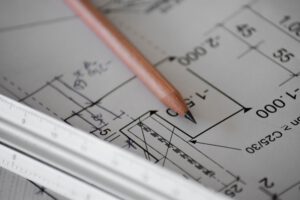Design-to-cost (DTC) is one of the most common strategies for cost reduction during product development and manufacturing. Cost is an important parameter to consider in even the earliest designs of a product. It is easier to design costs “into” a product, rather than remove them later. By making the right decisions in a design or concept early on, extra unnecessary costs that may be incurred by a design change later on can be avoided.
The concept of DTC extends beyond just design, to product specifications and the complete development cycle. DTC addresses costs including those labeled as recurring production costs, non-recurring costs, product costs, and product price or acquisition costs. For example, any environmental factors, expected maintenance that will be needed, or any other part of the process will be taken into account. However, DTC does not necessarily mean a product will automatically reach a defined target cost. It simply is about considering cost as a design parameter during product development.
To make smart design decisions, it is important to understand the factors behind a product’s manufacturing cost. A product’s cost structure starts with the basics: production materials and labor. Often these are the only factors that are examined during cost reduction initiatives. However, these are only a fraction of a product’s total cost.
There are many design aspects that affect manufacturing cost that designers can tradeoff in order to try to streamline their design. Are there areas in which manufacturing can be simplified? Are direct materials being used purposefully? Consider the factors below that may suit your product and needs.
Use standard parts.
Standard parts are typically easier to source and are simpler to combine with other parts. If manufacturing overseas, consider designing using the metric system rather than imperial (US standard). Parts with metric units are often much easier to find and makes the project fit together much more seamlessly. Additionally, using standard parts throughout the design where possible (ex: all fasteners are the same part number) make things easier more efficient and more cost effective.
Avoid non-spinning types of curves for machining.
As an example, curves are one design element that are more difficult to achieve than their straight edge counterpart. This is not say it cannot be achieved, however certain design elements may complicate production and take longer to finish, which will in turn add costs. Thinking in this way can help determine which elements are truly important and which are not worth the cost tradeoffs.
Use high-volume parts.
Standardizing parts and increasing the volume of an order will reduce costs in a couple of ways. Whether 200 units or 20,000 units are produced, the associated NRE expenses will still incur. This means that cost per unit will reduce with an increase in order volume. Standardizing on frequently used parts will lead to a decrease in indirect overhead, and higher volumes of these parts may yield to supplier discounts.
Reduce scrap.
Is the product designed in such a way to reduce scrap as much as possible without interfering with the essence of the project? Scrap mostly comes from non-reversible manufacturing processes such as gluing, painting, or other interconnections that cannot be reworked. The cost of scrap can be significant. Scrap rates are steered by both designs and processes.
Minimize number of parts and types of processes.
Manufacturing cost and supply chain cost increase dramatically with the total number of parts and different types of processes (such as casting, machining, molding, etc.) that parts are made from. To eliminate or standardize is a leading guideline of lean design. Minimizing the number of parts total and reducing the unique parts count can save in product costs as well as labor. If a part can be combined with others or can be standardized to exactly match other parts, the product will be less complex and simpler to produce.
Don’t use materials that are beyond your needs.
There isn’t much of a reason to use more expensive materials, when a cheaper one would do. For example, is it a hidden part that no one will see? Don’t bother spending more to add a visually nice appearance in this case. Similarly, don’t try to make up for an unremarkable design with expensive materials. Also remember your market when choosing materials. Nicer, more expensive materials will increase your product cost. Will your customers be willing to pay that inflated price? Or would they rather more standard materials that function similarly for a cheaper price?
Reduce weight and size.
If thinking far ahead during the design process, you might consider the effect of both product weight and size on logistics costs. Since weight and size are typically standard factors calculated in to shipping rates, naturally creating a lighter weight product or designing it to take up less space could reduce shipping costs.
Simplify the design: eliminate unnecessary complexity for the purpose of the product.
Adding simple elegance to a design is typically appealing to consumers due to the high quality, performance, and visual aesthetics that generally go with it. In some cases, creating a simple design will reduce the time needed to produce and assemble a product, both in terms of production and labor. However, there is a fine balance between simplicity and “creeping elegance”. Make sure that any added elegance does not require specific parts that are difficult to source or that have a large logistics cost, especially if this doesn’t match your target market and price.
 Reuse existing designs and processes.
Reuse existing designs and processes.
Reusing a design saves nonrecurring design costs and helps the product get to market quicker. Since time is money, incorporating design elements and processes that have already proven to be effective will save. Once these are set, repeating orders is a breeze.
Avoid gold-plated designs.
Gold plating is the practice of making changes to a project that are outside the original specs or that overshoot the customers’ needs. Customers will not pay for features that overshoot their needs, but you will pay for the cost of including them. The added work that comes with a gold-plated design can be risky. The project may take longer than anticipated, changes can have a negative effect on existing functionality, or the customer may not even care for the excess of features. It is often best to focus on basic customer needs first, then sell them on additional features later if there is interest.
To be successful with DTC, it is important to establish cost as a constraint from the beginning of the design process. Although these factors sound simple, they often do get overlooked by many one way or another. DTC should be used as a constant reminder during the whole design and development stage. As part of the manufacturing process development team, E-BI can work with designers to provide real time quotes associated with a design. This could help to minimize product strategy grief down the road. Whether in materials, labor, design, or overhead, there are many strategies that, if executed well, can make a big difference in cost and the success of your product in the market.

